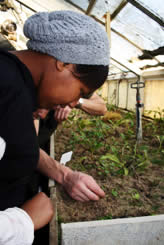 The last week of the school winter holiday was the time for learners from the Iimbovane Sugar Ant Schools to visit the Iimbovane ant laboratory to learn more about the wonderful world of ants. From the 4th July to 9th July 2010 seventeen Grade 10 learners from various schools in the Western Cape visited the laboratory.
The last week of the school winter holiday was the time for learners from the Iimbovane Sugar Ant Schools to visit the Iimbovane ant laboratory to learn more about the wonderful world of ants. From the 4th July to 9th July 2010 seventeen Grade 10 learners from various schools in the Western Cape visited the laboratory.
Sugar Ant Schools are schools that joined the Iimbovane project at the end of 2009. Educators from these schools received training and used the first half of 2010 to implement the project in their classroom. Schools completed their fieldwork successfully without the assistance of the Iimbovane project team. The samples were then prepared for preservation. The lack of sufficient microscopes however makes the identification of their samples impossible and so the Iimbovane ant laboratory opened up their facilities for learners from these schools.
Throughout the week the learners learned a great deal about South African biodiversity and why it is critical to look after and maintain our biological diversity. This was done through several lectures, interactive activities and excursions. Biodiversity science is as much a practical subject as it is theoretical and so learners made use of microscopes to identify the ants they collected.
 It was not all work and to add some fun to the week, participants visited the highly recommended Butterfly World near Klapmuts. This unique attraction consists of a tropical garden in a 1000 m2 green house which is home to a collection of spiders and reptiles that have been confiscated in illegal trade activities. Butterfly World imports approximately 500-800 butterfly pupae per week all year round. Learners also soon realized that biodiversity is not just about beautiful butterflies and scary spiders but more importantly for the role that each species fulfills in the ecosystem. This was carefully explained by Esther van der Westhuizen who presented interesting facts on the interaction between ants and butterflies. Learners were then given time to explore this amazing world of butterflies, an experience which they all enjoyed immensely.
It was not all work and to add some fun to the week, participants visited the highly recommended Butterfly World near Klapmuts. This unique attraction consists of a tropical garden in a 1000 m2 green house which is home to a collection of spiders and reptiles that have been confiscated in illegal trade activities. Butterfly World imports approximately 500-800 butterfly pupae per week all year round. Learners also soon realized that biodiversity is not just about beautiful butterflies and scary spiders but more importantly for the role that each species fulfills in the ecosystem. This was carefully explained by Esther van der Westhuizen who presented interesting facts on the interaction between ants and butterflies. Learners were then given time to explore this amazing world of butterflies, an experience which they all enjoyed immensely.
A visit to the Botanical Gardens and its newly renovated greenhouses offered the learners a glimpse of plant diversity. Plants species such as the Welwitschia mirabilis and the carnivorous plant, Heliamphora, were very popular with the learners. The watery syrup in the sugarcane and the smells of the coffee plant also gave a whole new meaning to the way the learners look at their morning coffee.
 The remainder of the week’s visit involved long sessions in the lab during which the learners identified ant samples. Learners were carefully taken through all the steps of identifying ants and after knowing the difference between “petiole and post-petiole” learners were left to try their own identification skills.
The remainder of the week’s visit involved long sessions in the lab during which the learners identified ant samples. Learners were carefully taken through all the steps of identifying ants and after knowing the difference between “petiole and post-petiole” learners were left to try their own identification skills.
In the evenings there was some time to kick up the feet and relax with environmental documentaries such as “An Inconvenient Truth” and “Hotspots”. The documentaries were followed by a discussion on the topic of the documentary.
On the final day of this programme, learners had to put their thinking-caps on and analyse data. In groups of two, learners formulated their own project. Many of the learners indicated that they would be interested to use these projects as a starting point to enter the Eskom Expo for Scientists that takes place in August.
Besides being very tired from a busy programme, learners felt that they have learned a great deal about the various aspects of biodiversity science and the importance of doing research in order to preserve our biological diversity.